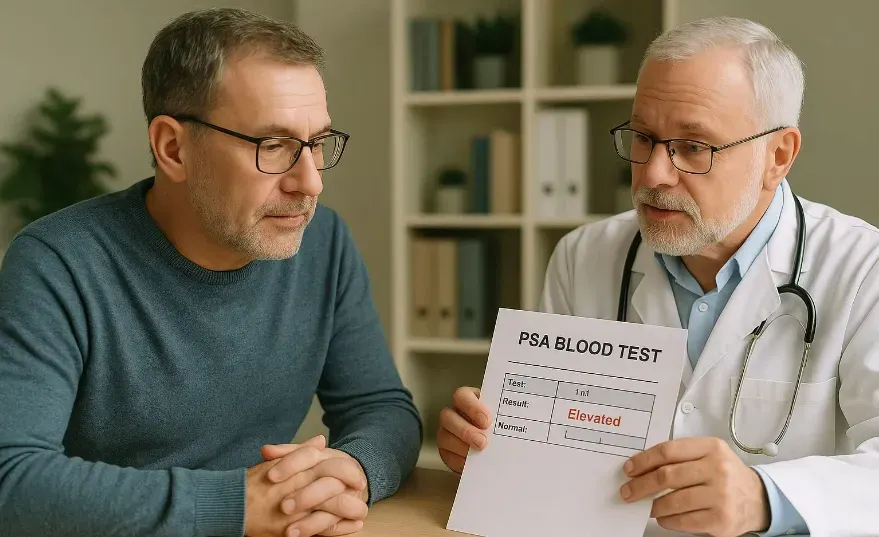What to Do If Your PSA Test Is Abnormal: A Proactive Guide for Men’s Health

Key takeaways
- PSA testing must be interpreted with context: free PSA, density, and velocity matter more than one number.
- Rechecking abnormal PSA levels helps differentiate temporary spikes from real concern.
- Early baseline PSA testing and tracking over time can prevent delayed prostate cancer diagnoses.
- Patients who understand PSA metrics often catch warning signs before doctors do—self-advocacy matters.
A spike in your PSA score can feel like a red flag—but it's not always a clear sign of prostate cancer. The prostate-specific antigen (PSA) test remains one of the most widely used tools for prostate cancer screening, but understanding how to interpret it—especially when it’s abnormal—can be the difference between timely intervention and unnecessary panic.
What Exactly Is PSA?
PSA is a protein naturally produced by the prostate gland, and its primary biological role is to help liquefy semen. In semen, PSA levels are incredibly high—upwards of 100,000 ng/mL. But PSA shouldn't be in your blood at such high concentrations. When it shows up in the bloodstream, that’s often because small amounts have "leaked" from prostate tissue.
Most of this PSA in the blood is bound to proteins, but a smaller portion floats freely. This balance between free PSA and bound PSA can give valuable insight into whether elevated PSA is more likely to stem from a benign condition—or something more serious like cancer.
When Should You Be Concerned About an Elevated PSA?
A PSA number alone doesn't tell the full story. For example, age, prostate size, inflammation, infections, recent ejaculation, or even bike riding can all cause a temporary spike. That’s why context matters. Generally, here’s how PSA levels are interpreted:- Under 1 ng/mL: Very low risk; usually no need for further testing.
- 1–4 ng/mL: Could be normal depending on age and other factors.
- Over 4 ng/mL: Needs further evaluation.
But raw numbers are only part of the equation. What matters just as much—if not more—is the trend over time and how it behaves relative to prostate size and free PSA percentage.
Free PSA: The First Clue Toward Benign vs. Cancerous
Free PSA refers to the unbound portion circulating in the bloodstream. It's a vital discriminator between benign prostate conditions like BPH (benign prostatic hyperplasia) and malignant processes.
- If 20% or more of total PSA is free, that’s generally reassuring—more likely benign.
- If less than 10–15% is free, the concern for cancer rises.
However, free PSA is most useful when total PSA levels are in a certain range—typically 2–10 ng/mL. Below that, the risk of aggressive cancer is so low that measuring free PSA adds little clinical value.
PSA Density: Measuring PSA Relative to Prostate Size
As men age, the prostate often grows—especially under the influence of metabolic syndrome or hormonal shifts. PSA levels often rise along with it, which can cloud interpretation.That’s where PSA density comes in. It’s calculated by dividing the total PSA by the volume of the prostate (usually measured via ultrasound).
- A PSA density below 0.10 is generally considered low-risk.
- Above 0.15, and concern starts to rise.
PSA Velocity: How Fast Is It Rising?
Think of PSA velocity as your PSA’s speedometer. It's not just about where your number is now, but how quickly it got there.- A rapid rise in PSA—especially more than 0.35–0.75 ng/mL per year—can signal potential concern, even if your PSA is still within normal limits.
- Conversely, a spike followed by a return to baseline may suggest something benign, like prostatitis or recent activity.
That's why one elevated PSA doesn’t justify panic. Many physicians prefer to recheck PSA within a few weeks, especially if there’s been a sudden uptick.
Advanced Testing: PHI, 4K Score, and More
When standard PSA and free PSA tests are inconclusive, more advanced blood tests are available:- Prostate Health Index (PHI): Incorporates total PSA, free PSA, and [–2] proPSA (a PSA isoform linked to aggressive cancer).
- 4K Score: Uses a panel of kallikrein markers, including free and intact PSA, to assess the risk of high-grade cancer.
These tests provide a probability score for the likelihood of having an aggressive form of prostate cancer. While they come at a higher price tag (around $1,000), they can reduce unnecessary biopsies and offer greater clarity in ambiguous cases.
Should You Be Tested Every Year?
Official guidelines vary:- The U.S. Preventive Services Task Force recommends shared decision-making starting around age 55.
- The National Comprehensive Cancer Network (NCCN) suggests baseline PSA testing at age 45.
Dr. Schaeffer and Dr. Attia argue for even more frequent and individualized screening. They highlight the value of baseline PSA in your 40s, with periodic retesting to establish personal trends over time.
Here’s the logic: A free PSA test is inexpensive, often less than a pack of gum. When combined with PSA density and trend analysis, it gives you powerful insight without high cost or risk.
Patient Advocacy: Why You Need to Take the Lead
One striking takeaway from the discussion: Patients themselves often detect their own cancers by paying close attention to PSA velocity, density, or trends—even when their doctor dismisses concerns.
This underlines a critical truth: No one cares more about your health than you. If your PSA is rising, even slowly, and especially if it’s combined with a low free PSA or rising density, advocate for further evaluation. Push for a recheck, a second opinion, or a more advanced test if necessary.
Citations:
https://www.cancer.gov/types/prostate/psa-fact-sheet
https://www.uspreventiveservicestaskforce.org/uspstf/recommendation/prostate-cancer-screening
